Story and Photos by Jonathan Sharp
Last week we took our readers to the top floor of the Museo dell’Automobile in Turin. This week, Jonathan and Jose Sharp complete the tour, taking us down to the first floor and the ground floor. Click on photos to see much larger image.
The first floor which contains the exhibit “Man and the Car,” is spread over eight rooms. It explains “the relationship the modern world (meaning us) has with the car.” This display contains a wide selection of automotive jewels, and the culmination of this portion of the museum is the display of Formula cars.
The main display area is in the form of a slightly banked display ramp containing an evolutionary lineup of single-seater racing cars, from a 1907 Fiat F2 130hp to a contemporary Ferrari F1 car. This impressed my wife Jose. “I enjoyed the visual displays of the grid of cars set up with a moving film display behind them. It began with men on horses followed by a carriage and then chevrons and fire. It was set to music which made you think the cars were getting ready to go, and then together with the chevrons and fire made it seem as if the cars were flying along.”
At the end of this lineup of single -seaters, sitting on a revolving round turntable tucked into the corner, was the Pininfarina Sigma F1 safety concept car.Opposite the main line-up are three alcoves, each of which displays a significant racing car. On either side of the main entrance into this display area is a lineup of black and white life size photos of the great racing drivers.
Once you have recovered from this sensory overload it is time to take the stairs to the ground floor for the exhibit “Cars and Design.” This display includes many classic examples of the Italian Art of Car Design. Another section of this display area uses pictures, models, and filmed interviews with many of the most inspirational designers of the 20th Century to explain to us where they found their influences and inspirations. “Also along one corridor were lots of little window,s each with a display of the things which inspired leading car designers, together with examples of their work,” noted Jose.
Having been completely impressed by the entire Museum experience you enter back into the main Piazza which is used to house temporary exhibits. At the time of my visit it was crammed full of cars and displays relating to 45 years of Martini Racing which we covered previously.
Jose enjoyed the fun displays as well. “There was a new Fiat 500 on display with a robot moving a model car, showing how the robot worked. When I first saw it I thought it was covered in a clear stick on paper with pictures of cars. On closer inspection it was covered in cling film with thousands of model Fiat 500’s in different colors set between the cling film and the actual car which was very clever.”
Just off the Piazza is the ubiquitous cafe/restaurant but this being Italy, the restaurant menu features risotto, pasta, fresh fish and possibly the best coffee in Turin. Not a hamburger or hot dog in sight. The attached shop carries a very good selection of motoring books and souvenirs.
But the final word has to go to the restrooms with their bright green painted walls and ceiling just like the color of a 1970’s Lamborghini Miura.
Below, the themes and a selected number of rooms with images. Most of the text by the Museum and lightly edited.
FIRST FLOOR: Man and the Car
AutoTorino
Turin, city of the motor car: Over 70 car companies started up in Turin in the twentieth century, as well as over 80 bodywork manufacturers. Turin is still the center of excellence in the project and design fields. A map imprinted on the floor will allow you to reconstruct this extraordinary role of the motor car “capital”.
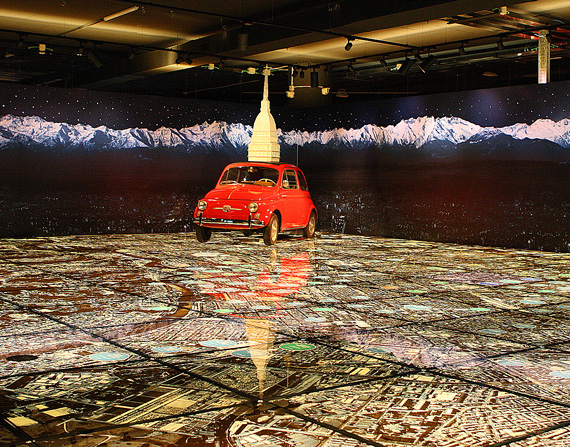
This display gives the viewer an idea as to the size of the car industry that has been based in Turin. The map contains dozens and dozens of circle-shaped stickers, each one placed upon the map at the location of each company involved in the car industry whether that was a car maker, or a carrozzeria. The spire on the top of the Fiat 500 is the Mole Antonelliana, a Turin land mark.
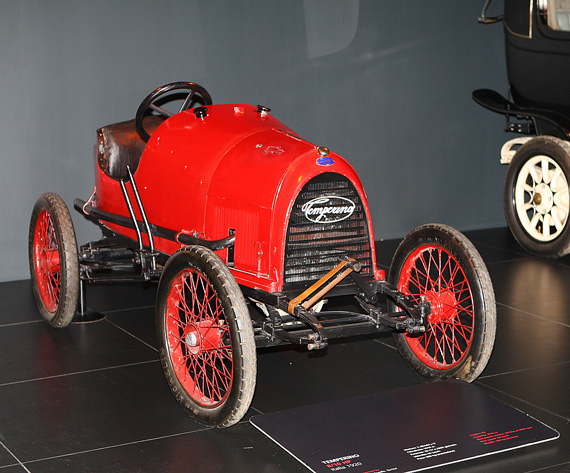
In 1919, three brothers, Maurizio, Giacomo and Carlo Temperino, set up a factory in Turin to build small, two-seater runabouts powered by a two-cylinder air-cooled engine. The 8/10 HP was the firm’s first model and enjoyed a certain measure of success. A sports car version, too, chalked up a number of victories, including the Sassi-Superga (Turin) hill climb in 1919.
Mechanical Symphony
Art is not necessarily exclusively a prerogative of painting, sculpture, or music; there are expressions of mechanical excellence. In this room, the hidden components of the motor car are brought together, as in a great symphony: these are the engines, frames, and wheels which constitute the car’s interior essence, contrasted with the bodywork, which is its exterior clothing.
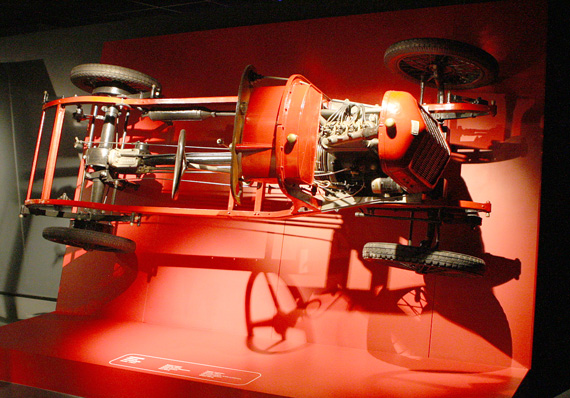
Founded in Turin in 1910 by Antonio Chiribiri, this firm began with small runabouts before moving on to more ambitious projects in 1919.These consisted of a line of prestige models, including a sports car (it was on a Chiribiri that Tazio Nuvolari began his racing career). The Milano (shown here as the chassis) was the most successful and renowned for its precision engineering.
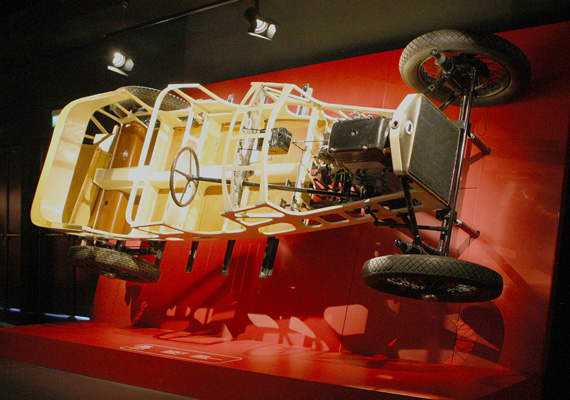
Among its many firsts, Lancia’s Lambda presented a weight-bearing torpedo body forming a single, light and rigid union between the chassis and the shell. This unitary chassis offers a unique view of the extraordinary nature of Vincenzo Lancia’s masterpiece, which made a major contribution to the development of the modern motor car.
Metamorphosis
Does the human being turn into a robot or does the robot take on human form? Industrial mass-production, experimented for the first time in America in the Ford workshops constructing the Model T (15 million motor cars in 19 years), was the “driving force” of the twentieth century.
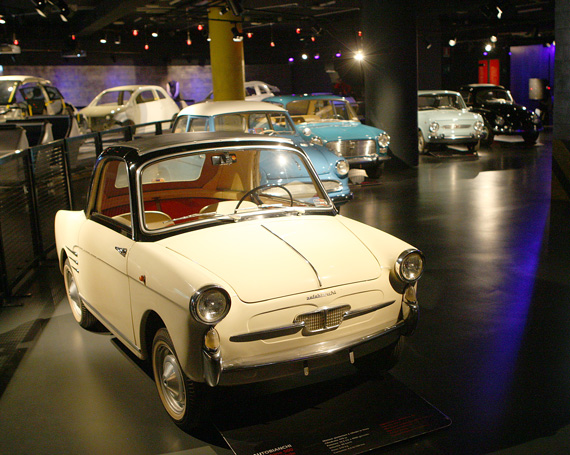
The first non-standard automobile to be produced on an industrial level using the mechanicals of an existing model was the Fiat Nuova 500.The Bianchina was an immediate success when it was presented in September 1957. During the period of production from 1957 to 1969, about 300,000 cars in various versions were each carefully elaborated in every detail.
Formula
Speed is one of the great modern myths. In a sort of exciting, dream-like cavalcade, all the racing cars in the collection, from all historical periods, meet here to race together towards the finishing line, in front of the eyes of visitors.
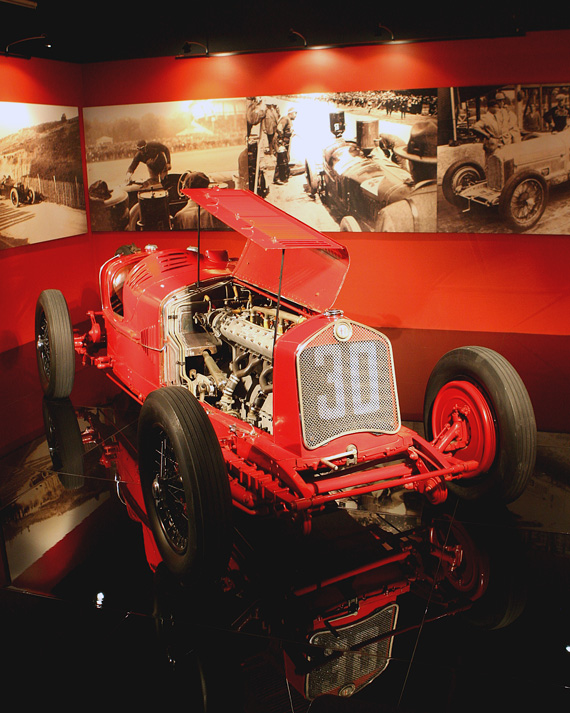
This is a modified version of the P2 racing car, designed by Vittorio Jano, which on its debut in 1924 won the 200 Miles of the II Circuito di Cremona, driven by Antonio Ascari. This model was modified in 1930 and it too made a name for itself in various races, including the Circuito di Alessandria and the Targa Florio, once again in the hands of Achille Varzi. The P2 model is considered the progenitor of all Alfa Romeo’s famous racing cars.
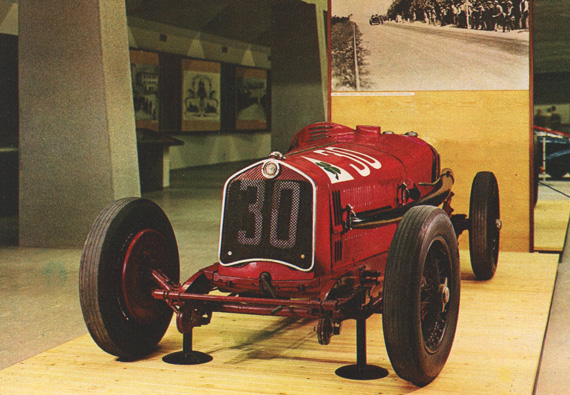
The same car as displayed at the Biscaretti Museum in 1964, giving one an idea of how dramatically the displays have changed. From a postcard purchased at the Museum.
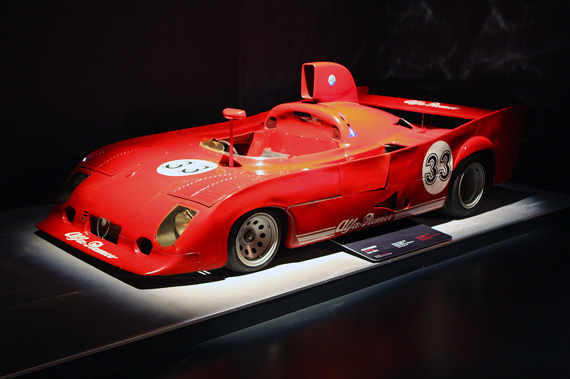
This is the sports car with which Alfa Romeo won the World Makes Championship in 1975. The car's secret was a flat, opposed twelve-cylinder, 3-liter boxer engine, powerful and fully reliable, and characteristic on account of its super-square measurements (bore 77 mm x stroke 53.6 mm) which supplied the maximum engine power at 11,000 rpm. Aerodynamic bodywork fitted with a spoiler boosts the rear wheel grip.
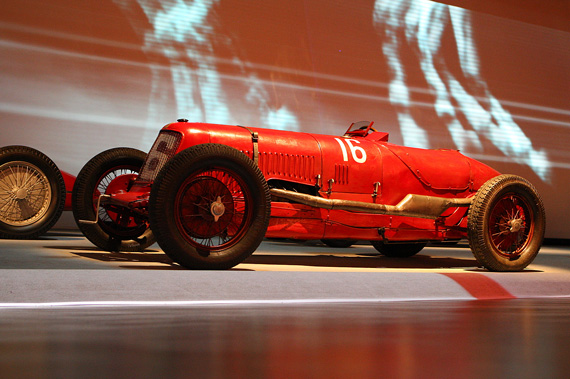
The Maserati brother’s second racing car built at their Bologna factory, this model is derived from the 26 which made its debut when it came in third at the 1927 Targa Florio driven by Alfieri Maserati. The 26 B mounts a straight-eight engine, supercharged with Roots blower and twin overhead-camshaft timing. In 1928 the car won the Italian Makes Championship thanks to the skill of drivers such as Ernesto Maserati, Baconin Borzacchini, Ajmo Maggi, and others.
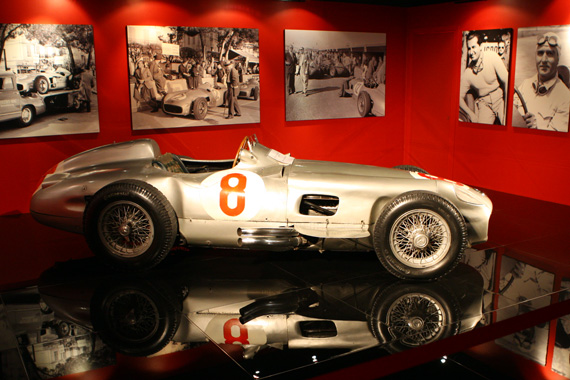
In its day, this was the most innovative Formula 1 car on account of its straight-eight motor equipped with positive-drive valve timing, two plugs per cylinder and direct injection. The Mercedes-Benz W 196 mounted two kinds of bodywork: conventional with uncovered wheels, and streamlined for very high speed racing.
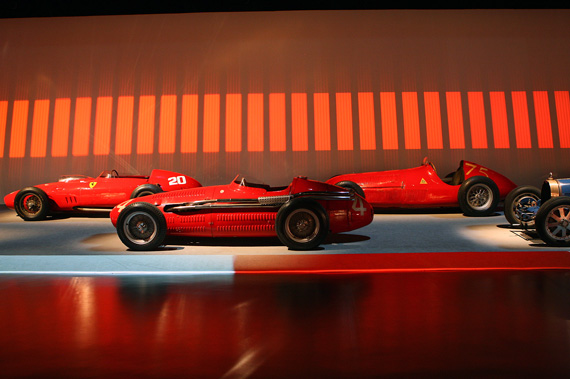
Three Italian masterpieces created by three very different companies: The Alfetta 159, the Ferrari 246 Dino, and the Maserati 250F. Note the background as you click for large image.
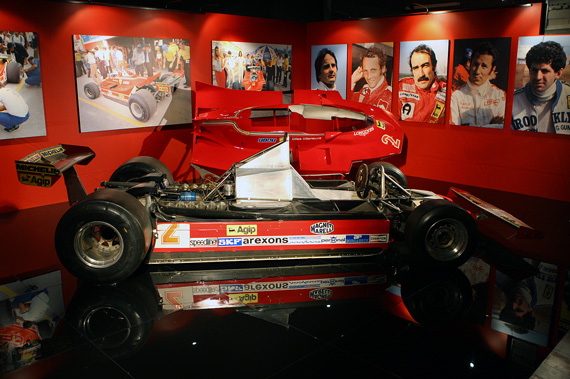
After Jody Schekter became World Champion Driver in 1979, Ferrari presented the T5 version in 1980, while preparing to launch the 126C fitted with a turbocharged power plant. The 312 T5 is another example of Ferrari’s series with the transverse transmission (hence the T) favored by its design philosophy. The body is fitted with miniskirts to obtain the ground effect.
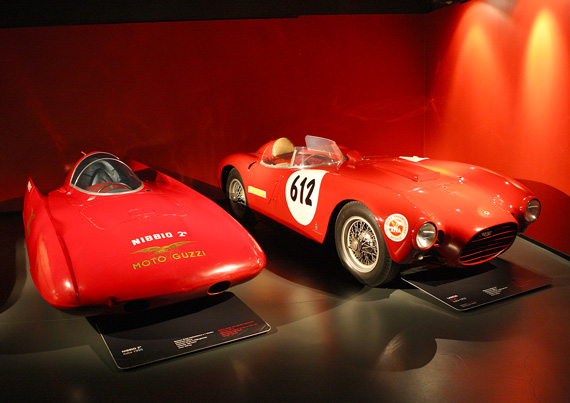
Nibbio 2 was a special record-breaker built by Giovanni Lurani. It had independent 4-wheel suspension and fitted with a Guzzi one-cylinder motorcycle engine, and Ghia bodywork. Between 1956 and 1958, the Nibbio 2 set up some international 350 cc class speed records at Monza. Next to it, the last of a series built by Lancia for sports car competition; the D 24 carried Manuel Fangio, Piero Taruffi and Eugenio Castellotti to the first three places in the 1953 Carrera Panamericana.
Design
The word “design,” as used in car manufacture, is an English term meaning “industrial drawing,” or “project” and indicates the design activity that is not just defining the external features of an object, but it also explains the functional, structural, and aesthetic relationships that identify an industrial-type product. We see here some extraordinary examples of the Italian school of coachbuilders and designers, which is still virtually unequalled at a world level, and able to adapt its creativity and design skill to the needs of large industries.
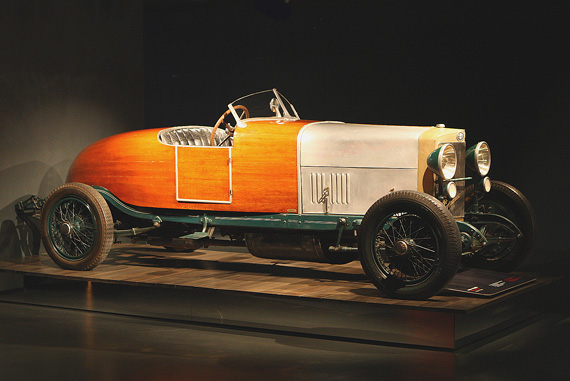
The Alfa Romeo RL SS was produced between 1925 and 1927 for international customers looking for top performance. It was powered by a straight-six engine, and custom-built bodies were mounted on its standard chassis. The example on display is a “spider bateau” version, so called because the tail looks like an upside-down keel, and has an aluminum bonnet and mahogany rear end. This unique bodywork was made in 1926 by Wilkinson of Long Island, New York, for a well-to-do American Alfa enthusiast.

Alfa Romeo Disco Volante with one-off bodywork by Touring of Milan. The car’s biconvex profile and flattened shape resemble the wing of an aeroplane. Next to the Disco is a 1964 Abarth 2400 Coupe with coachwork by Allemano, unique as it was Carlo Abarth's personal car.
GROUND FLOOR: Cars and Design
This is the last floor to be visited, entirely devoted to design, the creative path that precedes the production of a motor car. 1,200 square meters and one single large room tell us about how the great designers of today interpret the themes of individual mobility, safety, speed, comfort, and style. Achieving certain objectives is difficult, exhausting and time-consuming, and involves all the designer’s abilities and resources. Listening to how some of the greatest designers in the world have done it in the past, are still doing it today, and will continue to do it in the future, is an enormous pleasure that is not to be missed.
Morphing
The lines of these cars certainly differ and this is intentional; each one is specific to its brand and origin. But they have one thing in common; each speaks of the character of their time. They are evidence of a continuity of formal expression that translates into a superimposition of shapes, but without detracting from their diversity, originality, and uniqueness.
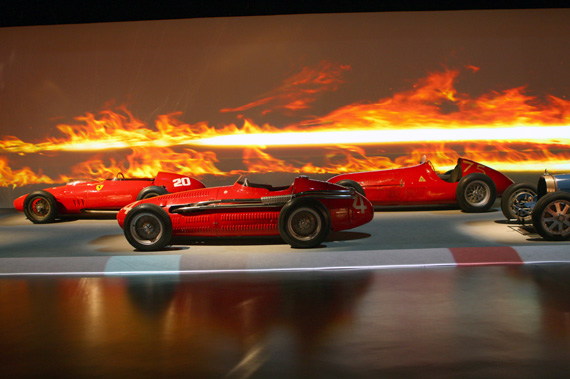
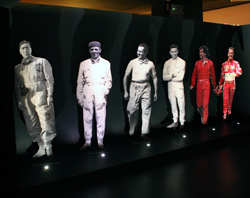

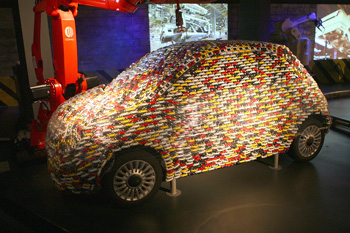
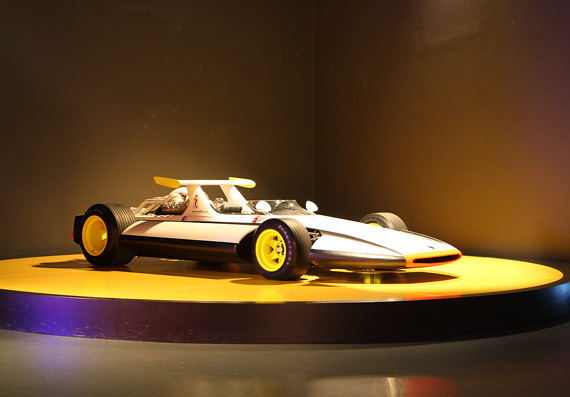
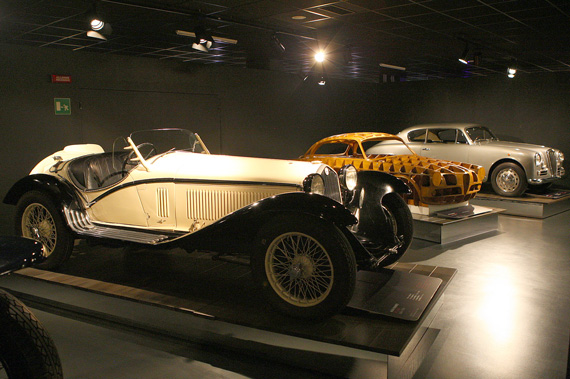
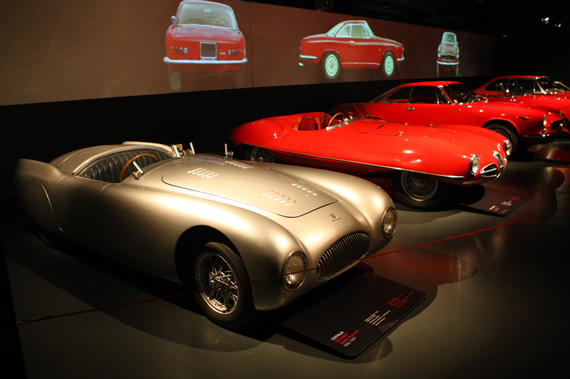
Wonderful article, great cars, I must go there !
Wow. It just might be worth a trip to Itlay — just to see this museum! Thanks for the superb coverage.